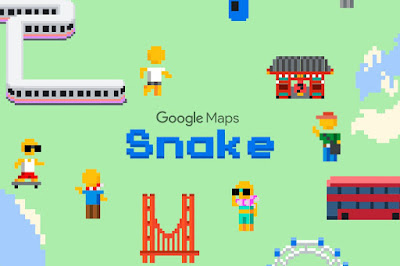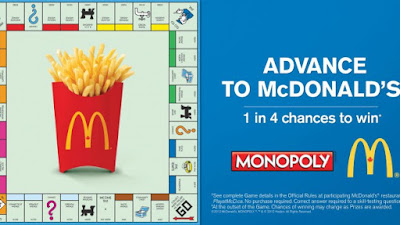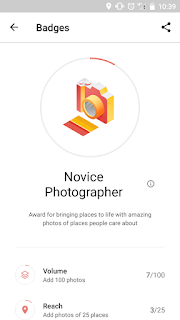Google Maps Applies Gamification by Using Easter Eggs
Google Maps Applies Gamification by Using Easter Eggs
We all love surprises, don’t we?
Well, at least the pleasant ones; the ones that bring a smile to our faces and
relieve us momentarily from the monotony of our daily lives. In the marketing
or business parlance, such surprises are often referred to as “Easter Eggs”.
Easter Eggs are pleasant little surprises discreetly put into the product or
service offered by marketers to surprise their customers. In the online
context, they are hidden gems, features, or moments of surprise buried within the software and throughout the internet. They're designed to catch you off guard
and make you smile, that is, if you can find them. They may or may not offer
functional utility, but they are believed to enhance the perceived value of the
brand in the minds of the customers. Easter
eggs are game elements that are fun to build and fun to find because they
reward users that care enough to find and get excited about them. They create
this feeling of being an insider with the application or company, which can be
incredibly valuable in terms of brand loyalty and engagement.
Google Maps was launched more
than a decade ago and since then it has always been one of Google’s most
popular platforms. With Google investing
heavy resources to improve its utility and value to its users, Google Maps has
become the preferred map navigation app across various mobile devices and
platforms. Integrating a host of services and adding utilities like Street View,
Navigation and Local Guides the platform has a large user base across the
world. In order to help create greater affinity towards the brand and the
service, Google has gamified the map user experience by smartly placed certain
Easter Eggs within the platform for users to discover as they intuitively engage
with the app.
These are a few examples of Easter Eggs that have found fandom
among users of Google Maps:
The Pegman and the Loch Ness Monster:
This is an Easter Egg that is
permanently embedded into the application. It is the little yellow person like
icon in the bottom right corner of the map screen. Its function is to trigger
Street View which lets you virtually tour places far, far away by simply
dragging and dropping the yellow man icon anywhere on the map.
Another Easter Egg or element of
surprise added into the Peg Man feature is the use of the Loch Ness Monster. All
you have to do is to search for “Loch Ness” and you will see the Google Maps
Pegman button change in the bottom right corner.
Use a Dragon as a Means of Transit:
When one seeks directions between
Mount Snowden (North Wales) and the Brecon Beacons (South Wales) by Mass
Transit, one option that appears will be to take the trip using a Dragon. The trip is estimated to take around 37 minutes to complete. However absurd as it may
sound, given the estimated time of flying with a dragon or the fact that they
chose to use a dragon as a means of transit, users can find a sense of relief from
the monotony of their regular transit by fantasizing about how it would be to
fly on a dragon on their way to a destination.
Pokémon on Google Maps:
Google Maps teamed up with
Nintendo to employ the popular character Pokémon into the Google Maps interface
in 2014 where users were engaged to catch Pokémon inside of the Google Maps
app. This later led to the development of the massively popular ‘Pokémon Go’
game.
The Tardis from Doctor Who on Google Maps:
Fans of the popular Doctor Who
franchise found the Tardis integrated on the streets of London in Google Maps.
Users could actually enter the Tardis from the Street View to checkout and
explore its spacious interiors. The Easter egg can be accessed by
clicking on the double-white arrows that appear in front of the police
telephone box outside the Earl's Court subway station.
Navigate with Mario Kart:
To celebrate World Mario Day on
March 10th, 2018, Google Maps teamed up with Nintendo to introduce
Mario Kart as a GPS marker for the navigation system. Users when they would tap
on the ‘Prize Block’ question mark in the bottom right corner of the screen to
trigger Mario Time. This would then lead them to tap on the ‘Let's-A-Go!’ button. the GPS marker would turn
into Mario driving his familiar racer from Mario Kart. The character would travel
along the route with the user until arriving at the destination. This Easter
Egg was so well detailed that they even included original sounds made by the
character in the game environment with animations like throwing bananas, from
the game into the app.
Where’s Waldo Game on Maps:
As part of their April Fool’s Day
celebrations in 2018, Google Maps introduced the popular children’s book based
game “Where’s Waldo?” into the app platform. They ran the game for an entire week where users saw a waving Waldo on their screens when they accessed the Google
Maps platform on their phones and other devices. They would tap on the little
Waldo icon in a place which would bring up a page from one of the classic books
and they could go about searching for Waldo and his friends Wenda, Woof, Wizard
Whitebeard, and also the villainous Odlaw.
Snake on Google Maps:
This year for their April Fool’s
Day Easter Egg, Google introduced the classic ‘Snake’ game to Google Maps
that allowed users to play the popular game title themed around major cities.
Users could play as an ever-growing double-decker bus by snapping up passengers
in London for example, or as a cable car in San Francisco or a commuter train
in Tokyo. They could also choose a "world" map if they were
interested in playing on a planetary scale.
Easter eggs prove how
entertaining the user is the key to their loyalty, no matter what product,
solution, or information they're looking for. Easter eggs are a popular tool
used by game designers to surprise and sustaining the ‘joy of discovery’ in
gameplay. It is no surprise that service providers like Google Maps are
integrating such elements into the service which is essentially a call to
explore the service more deeply.
Dr. Manu Melwin Joy, Assistant Professor, School of Management Studies, CUSAT and Sebastian Panattil, Research Scholar, School of Management Studies, CUSAT.






















Comments
Post a Comment